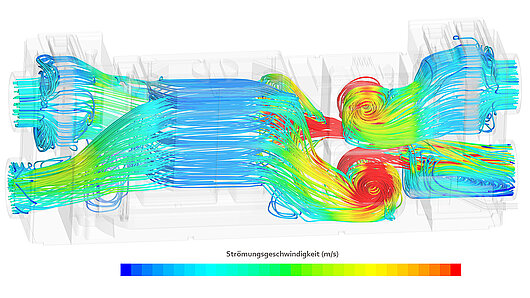High-Performance Computing Center Stuttgart

Supervising this work is Dr. Andreas Lucius, an engineer in ebm-papst’s pre-development department who evaluates and develops new computational methods for aeroacoustic simulation. Although the company has used simulation to model aerodynamics on its in-house compute cluster for many years, aeroacoustic simulation has other requirements that can be best addressed using a supercomputer like Hawk.
“We have a small computing cluster that is sufficient for many traditional aerodynamics simulations, but aeroacoustic simulations require more performance,” Lucius explained. “We need to use a very fine computational mesh and other kinds of modelling approaches in order to resolve small turbulent structures. This can quickly use up more than 10,000 CPU hours, requires highly paralleled hardware, and takes too long on our own systems. In situations like these having access to HLRS’s supercomputer helps us to get our results much faster.”
Before being sold on the market, ebm-papst’s fans must undergo rigorous testing. This includes experimental studies conducted in a wind tunnel at the company’s Mulfingen headquarters. In addition to performing standardized measurements of noise performance the engineers use an array of highly sensitive microphones, a so-called “acoustic camera”, to determine locations on the rotating fan blade where noise is produced. The system is very helpful during product development, but requires that many sophisticated, expensive microphones be placed around the laboratory. In an aeroacoustic simulation, however, little additional work is required to place as many virtual microphones in space as needed. This approach improves the quality of the team’s ability to localize sources of noise.
When modeling a spinning fan, the engineers use design data about the machine and computationally subdivide the area surrounding it into a fine-grained mesh. Using commercially available software, they then calculate how air moves in each of those cells over time. Based on physical principles, the simulations help the engineers to identify locations where unwanted turbulence or fluctuations in air pressure might be occurring. In both situations, pressure waves are produced in air that the human ear perceives as sound.
At ebm-papst, aeroacoustic simulation is used in an iterative way as a complement to experiments. When a new fan is in development, simulations can provide early information that make it easier for engineers to arrive at quieter designs more quickly. At the same time, data generated by experiments can be used to validate and improve the precision and trustworthiness of computational models.
This approach has also helped the company in optimizing its standards testing site. During laboratory tests tones are measured together with a fan’s blade repetition frequency and multiples thereof. In theory, the generation of tones should not be significant for undisturbed wind tunnel flow. In one case, however, the measurement identified an unexpected sound. When Lucius ran a simulation on Hawk that accounted for the fan and the surrounding laboratory, it clearly identified the source of the noise as a turbulence structure located above the fan that was being produced by the interaction between moving air and the wind tunnel’s sound insulation panels. When compared with experimental data captured by the microphone array, the technicians confirmed the results of the simulation, and changed the shape of the insulation panels to eliminate the tones. In the standardized noise performance measurement the level of the tones could be reduced by up to 10 dB and the level of acoustic power by up to 1 dB(A).
For the company, the lower cost of using HLRS’s system in comparison to commercial cloud providers is showing economic benefits. “Whenever we conduct an experiment we need to build a prototype, operate the wind tunnel, and make measurements. All of those things cost time and money,” Lucius explains. “As the precision of aeroacoustic simulations gets better, this approach has enormous potential to save money and speed up the development process.”
Lucius anticipates that new methods and access to larger and more diverse kinds of HPC systems could open new opportunities for R&D at ebm-papst.
Providing customized solutions for manufacturers is already a hallmark of the company, and when a customer is interested in building one of its fans into a specific air conditioning unit, for example, it is possible to test a prototype experimentally in the wind tunnel. In such complex systems, however, simulation is currently very computationally expensive. “Here we’re no longer talking about 10,000 CPU-hours, but more like 100,000 CPU-hours,” Lucius says. “These are situations that are very interesting and we are currently searching for methods that could reduce computing time even for such complex cases. Our goal is not only to be able to analyze the aeroacoustics of such complex installation cases, but also to optimize them mathematically using many simulation runs.”
Lucius computes primarily on CPUs, the traditional workhorse processors for HPC simulation. With the growing availability of GPU-enabled flow solvers, it will be possible to perform calculations faster in the future. One relevant approach is the lattice Boltzmann method, which is well suited to GPUs because of the processors’ architecture. As such methods become more mature, they could open new opportunities for modeling complex aeroacoustic systems. GPUs also offer the added benefit of using significantly less energy in comparison to traditional CPUs, a factor that is also important for ebm-papst.
In addition, Lucius sees possibilities in the new field of artificial intelligence. “Through our experiments, ebm-papst has accumulated measurements of all kinds, including fluid dynamics, aeroacoustics, electric, and thermal data,” he said. “The question we are considering now is how this data could be leveraged for the future.” Here, too, access to high-performance computing could be helpful, as algorithms using neural networks could perform data analyses that enable faster evaluation of designs during product development. AI could also make it possible to run large numbers of optimization simulations, an approach that is currently computationally expensive using CPU-based systems.
Although it will take time for such methods to develop, these perspectives suggest that high-performance computing will continue to provide critical tools for pioneering companies working at the frontiers of engineering.
—Christopher Williams